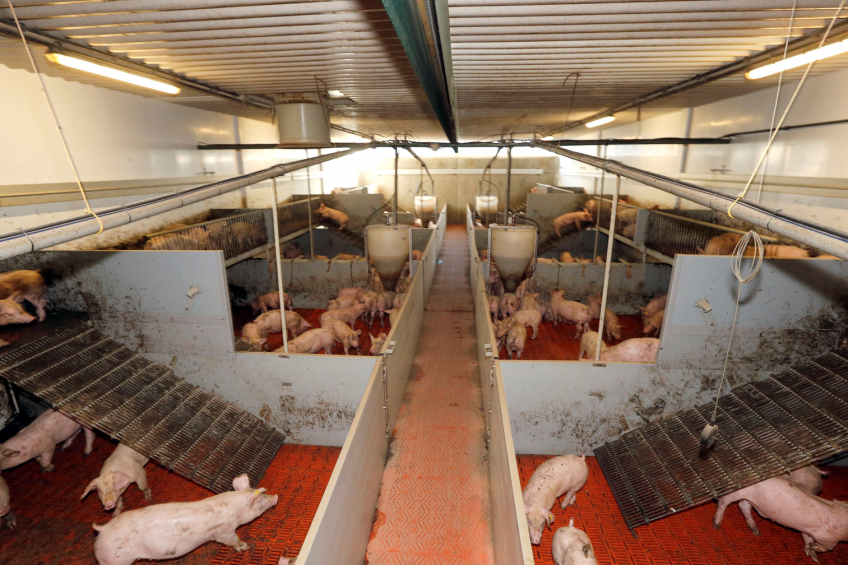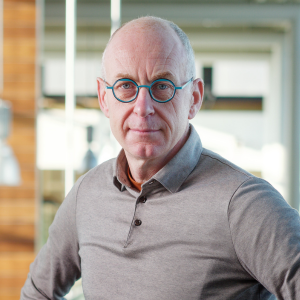Taking pig production to the next “level”

The brothers Theo and Bart Verhees, from Someren, the Netherlands, found a way to make more use of the available ?surface of their farm. By applying levels they could keep up to 25% more pigs.
At 10am, Bart Verhees, 51, and his brother Theo, 50, are having a morning break, together with their three employees. Just briefly joining them in the farm’s canteen, however, is not possible. The door has to be unlocked, to begin with. Subsequently, behind this door a large shower and dressing room can be found. Everyone will enter the pig houses freshly washed and dressed in farm wear.
It is just one example to show that maintaining a high health status is key at Verhees farm. The farm’s breeding stock was introduced from a reproduction farm in Lelystad, in the middle of the Netherlands. The animals were certified negative for Porcine Reproductive and Respiratory Syndrome (PRRS), Mycoplasma hyopneumoniae (M. hyo) and Actinobacillus pleuropneumoniae (App). Ever since the Verhees pig houses have been full, the brothers have worked with own reproduction animals. These all received a set of vaccinations, including PRRS, swine influenza and E. coli.
It is simply not an option to ignore animal health. In the pig-dense area around Someren, in the province of North Brabant, it is imperative that the sows are kept protected, the pork producers claim. In the agricultural development area where the farm is located, about 5 km outside the town, there are numerous relatively large pig farms. The brothers have 1,000 sows and 9,000 finishers. This makes their 2.5 ha large area completely full.

Levels as only option
The Netherlands, due to European legislation, has stringent regulations with regard to housing space for sows and pigs. To make sure that the Verhees brothers still manage to house the desired number of pigs on the limited area, they decided to construct a pig house with two levels in one pen. Admittedly, it was a gamble, says Bart Verhees, responsible for the finishers. The Pig Research Centre (VIC) Sterksel had been researching this type of housing before and the brothers had the opportunity to visit a colleague having something similar – but those were about all the references they could find. Now, with over 1.5 years of experience themselves, the pork producers can conclude the same as the VIC did: For pigs it doesn’t make any difference whether or not they have to climb; for pig producers, however, it is pretty hard work.
The latter can be seen in many situations, for example, when loading pigs, treating pigs, controlling the animals and cleaning the pig house. Their employees often complain after having cleansed the finisher pig department. Bart Verhees estimates that the levels require about 1.5 hours of extra labour per section.

Happy pigs
The pigs, however, appear to be happy in their levelled facility. The majority choose to be on the ground floor, with some looking up relaxed. Those going upstairs can do it without difficulty – walking up and down the slope is easy. The foldable metal ramp has been constructed at such a distance from the pen wall that no pig claw can ever get stuck between the wall and the ramp. There is some dry manure on the elevated floor, but this does not lead to a slippery floor or dirty animals.
In Verhees’ opinion, the levels have an added value for animal welfare, as they constitute a playing element. In addition, a pig that prefers privacy can decide to lie underneath the slope.

The concept requires some planning with regard to pen design. As from the moment of weaning, the pork producers have to combine two litters into one group, a mix of boars and gilts. The whole group is moved to one pen with a capacity for 24 animals. Should two litters contain more than 24 animals, the remainder is sold – about 1,400 piglets/ year.
The pens are spacious with 24 pigs. Making relatively large pens avoids the need of many of ramps, which would unnecessarily increase construction costs. In addition, this approach offers the opportunity to construct wide pens of 4.2 m, which allows sufficient space for lying and walking. As the pen design does not allow for a long trough, pigs are fed liquid feed from feeders.
Piglets are quick learners
Since last year, the grower house also received levels; here each pig has 0.4 m2 at its disposal. This is a condition for participation in the ‘Beter Leven (Better Life)’ scheme – a pork meat label in the Netherlands guaranteeing certain degrees of animal welfare – for more information see page 10 and further. Contrary to finisher pigs, the growers do pollute the level as grower manure is slightly more liquid and does not dry as quickly, explains Theo Verhees, responsible for sows and weaners. The levels therefore have been made with slatted floors, but this has not made any difference so far. As a result, the piglets look relatively dirty, despite a good vitality, condition or appearance. The brothers are still considering improvements to this part of their level approach.

Enjoyment
The piglets themselves, however, enjoy the set-up. Racing up and down the ramp the weaners consider the level and slope to be a great pastime. Some even fall off the slope without this leading to any permanent damage. The Verhees brothers noticed that the piglets which experienced the level system in the grower phase could also be found upstairs in the finishing house.
The levels are developed in such a way that they can be removed should the system not be successful. In the case of the finisher pigs, the levels will stay, as they yield up to 25% more pen space. The investment made for the level system amounted to €150 per m2. EU subsidies covered for 40% of this amount, related to investments in integrally sustainable pig houses.
|
|
[This article was featured in Pig Progress magazine no. 3 – 2014 – to see more published articles online go to Pig Progress digital]


 Verhees Farm, the Netherlands
Verhees Farm, the Netherlands Technical results of levelled pig house
Technical results of levelled pig house








